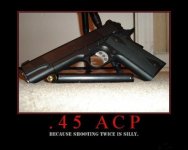GeorgiaShooter
Member
45acp has to be the round I shoot the absolute best, most accurate for me because I don't flinch, squint in anticipation of pain and without ear protection it's a nice round boom, non violent recoil and even my wife shoots the hell out of it. Accurate followup shots. Nice to reload, lots of ammo, bullet choices.
Whether a 1911 or my Governor it's just a pleasure and that makes me shoot it a little more effectively than anything else. Optimized state of the art 45ACP ammo really makes this an effective round.
Watch the ballistic gel, denim and leather penetration tests and compare to other calibers and it's clearly a great round. And the Hornady Critical Defense ammo is one of those new optimized ammos. It penetrates 4 layers of denim and leather then expands to twice it's diameter with a huge wide wound path and all the energy in the bad guys chest. There are nice comparisons of all brands in slow motion video and very clearly the damage is at the top of the ranking for every round they test. Sure some of the magnums are a little more explosive in how they expand through the gel but the 45acp is right up there at the top.
Whether a 1911 or my Governor it's just a pleasure and that makes me shoot it a little more effectively than anything else. Optimized state of the art 45ACP ammo really makes this an effective round.
Watch the ballistic gel, denim and leather penetration tests and compare to other calibers and it's clearly a great round. And the Hornady Critical Defense ammo is one of those new optimized ammos. It penetrates 4 layers of denim and leather then expands to twice it's diameter with a huge wide wound path and all the energy in the bad guys chest. There are nice comparisons of all brands in slow motion video and very clearly the damage is at the top of the ranking for every round they test. Sure some of the magnums are a little more explosive in how they expand through the gel but the 45acp is right up there at the top.


